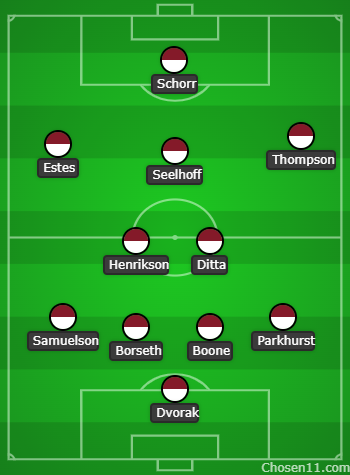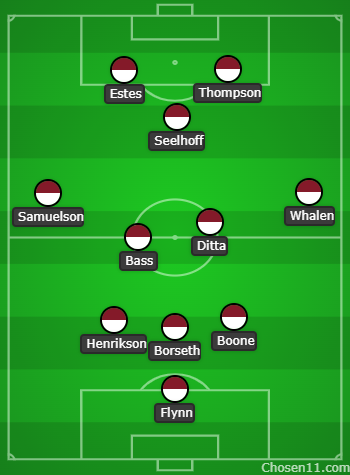Griz soccer has four wins in four games since changing formations a month ago. Here, Andrew Houghton breaks down what’s changed and why the new look is working so well. For an in-depth look at the process behind the change, click here.

For most of the past few seasons, Montana has played out of a very consistent 4-2-3-1 formation, the main advantages of which were two-fold: A) defensive solidity, and B) the way it put the Grizzlies’ best players in position to make plays. Both fullbacks, particularly Ava Samuelson on the left, could get forward for overlapping runs, and any of the midfielders could make runs through the middle, but the main objective was to get the ball to the wingers, particularly Skyleigh Thompson wide on the right.
From there, they could go one-on-one with their marker and either take a shot or put a cross in for 5-foot-10 center forward Delaney Lou Schorr, whose physicality and relentlessness made her a brutal matchup for opposing center backs.
That led to a lot of goals like Schorr’s first (and unfortunately only) score this year, in the season opener against Colorado College, when she was the only Montana player in the box for almost the entirety of the play:
Let's check out the second-half goal by Delaney Lou Schorr that won the season opener for the Grizzlies. pic.twitter.com/bUhhtEdhNk
— Montana Griz Soccer 🐻⚽️ (@MontanaGrizSOC) August 16, 2024
That worked so well a year ago, to put it simply, because Delaney Lou Schorr and Skyleigh Thompson were freaking awesome. Thompson had six goals and four assists and was the Big Sky Conference’s Offensive MVP. Schorr had five goals and four assists, and won the conference’s Golden Boot. Together, they combined for about a third of Montana’s offense, measured in goals and shots, just between the two of them.
This year, because of Schorr’s injury at Wyoming on September 8 and Thompson’s general struggles – she hasn’t scored or assisted a goal all season – the Griz have had to find different ways to score in the last month. To do that, they’ve started playing an aggressive, attacking 3-4-3.


Instead of just Schorr, they’re playing with three center forwards. Well, technically, just two center forwards, because at least one of the three is generally coming back towards the ball as more of an attacking midfielder – but which one of the trio is filling that role and which two are running behind can change from moment to moment.
To maintain width despite having three forwards in the middle of the pitch, two flying wingbacks push up high and wide, joining the attack to the extent that they’re really more straight-up wingers than wingbacks – in fact, the Griz call them wing-forwards. Two central midfielders sit in front of the center backs, although the more experienced Maddie Ditta generally also has freedom to join the attack as well.

Three center backs complete the formation, with all-conference defenders Charley Boone and Reeve Borseth handling most of the work and having (as they did in the 4-2-3-1) the freedom to dribble past the first wave of the opposing press and hit passes between the lines.
“(Having Boone and Borseth) makes your life so much easier,” Montana head coach Chris Citowicki said. “And then you really limit the role of that third (center back). You’re like, just do this and that’s it. … Reeve can do whatever Reeve wants because she’s proven she can do it. Charley’s the same. The third one who plays with them is still pretty limited, but once you show me you know what you’re doing, you can express yourself too.”
Two freshmen, Carly Whalen as the right winger/wingback and Hayley Bass next to Ditta in midfield, have been crucial parts of the new formation.
Whalen, from Issaquah, Washington, has a goal and three assists in four games since the change. Bass, from Divide, Colorado, has played at least 70 minutes in each of the last three games.
“Her simplicity is perfect,” Citowicki said about Bass. “She comes out of such a high-level club in Real Colorado. Her role right now is just to win it back and play two-touch, and she does that beautifully. She finds the right spot, she lays it off. Keeps the game simple.”
The main reason it’s all worked so well – a 9-0 goal differential and four wins in four games – is pretty simple math, namely that three players directly attacking the goal is better than one. Compare Schorr’s goal against Colorado College, above, to Jen Estes’ chance in the first half against North Dakota a few weeks ago:
No goal, but talk about great offense! pic.twitter.com/IasJ7P69Ol
— Montana Griz Soccer 🐻⚽️ (@MontanaGrizSOC) September 12, 2024
Estes misses the header, but the Griz have four attackers in the box against just two defenders and the goalkeeper. Someone’s guaranteed to be free, and Montana doesn’t have to rely on Schorr winning her one-on-one matchup against a defender to get a great look.
Not only that, but playing three forwards close together in the middle of the pitch allows them to combine with each other much more easily. There are plenty of opportunities to form passing triangles, execute give-and-gos, and much more. Check out Maddie Ditta’s chance against Northern Arizona last week:
Montana with another close opportunity pic.twitter.com/BOQaNIgUlG
— Montana Griz Soccer 🐻⚽️ (@MontanaGrizSOC) September 29, 2024
Ditta wins the ball in midfield, then the Griz play one, two, three short, quick passes to get her a great look at goal.
“I realized that our 4-2-3-1 was very isolated,” Citowicki said. “Chloe (Seelhoff) is by herself, let’s say if she was the right winger. Skye (Thompson) is by herself as a left winger. Jen (Estes) is by herself as a center forward. Now with this new formation, they play in close proximity to each other, so they can work off of each other, and it’s a togetherness thing. It’s not, ‘I hope Skye can beat her and cross it on her own.’ We’re actually attacking together, as opposed to just individually.”

Also, the positions on the pitch aren’t as narrowly constrained as they were in the 4-2-3-1. Other than Bass and the center backs, everyone on the field for Montana in the 3-4-3 has the license to seek out space whenever they see the opportunity. The forwards, in particular, are not locked into defined roles or spots on the field, and that causes chaos among defenses who are used to playing against set attacking patterns.
Go all the way back to Whalen’s opening goal against North Dakota, the first one scored out of the 3-4-3:
Riley O'Brien with the pass and Carly with the finish pic.twitter.com/VNhD1m2y4t
— Montana Griz Soccer 🐻⚽️ (@MontanaGrizSOC) September 12, 2024
The ball’s wide on the left with Riley O’Brien. The Griz don’t have a ton of runners into the box, just Estes and perhaps Thompson arriving late, so there’s no numerical advantage and not a ton of pressure on North Dakota’s defense. But Whalen, who’s been playing wide on the right for the first few minutes of the game, instead makes a run directly down the middle of the field. By the time the North Dakota defense figures out she’s there and not attacking the back post, where you’d generally expect the opposite-side winger in that situation, it’s too late.
“I’ve completely turned control over to the players, which is terrifying,” Citowicki said. “And it’s unusual, but it leads to chaos, because you don’t know how to defend that. Every picture, every attack, is different to the previous attack. You have no idea what’s going on. Chloe’s going to show up in a spot that nobody planned for Chloe to be in. Why is she there? I don’t know. That’s where she wanted to be – and we just scored because of it.”
Speaking of Whalen’s goal, another consequence of attacking with so many players is that it opens up a ton of space at the top of the box, in what soccer analysts call Zone 14 and generally consider some of the most valuable real estate on the field. Because of Montana’s pressure, opposing teams are so concerned about what’s happening closer to their goal that they can’t really cover Zone 14. They simply don’t have the defenders to do so when the Griz are creating so much havoc in the box – and so Montana is creating a ton of great chances from that spot on the field, like Ditta’s goal against NAU:
Carly Whalen's 3rd assist of the season pic.twitter.com/lrcQnIgL3j
— Montana Griz Soccer 🐻⚽️ (@MontanaGrizSOC) September 29, 2024
Freeze the clip when the initial ball goes in from Whalen and you’ll see six NAU defenders – more than half the team! – inside their own 18-yard box. When the play gets recycled to Ditta, they have to step back out to meet her, and she’s able to use the defender’s momentum against her to create space in a great area to get her shot away.
Lastly, Montana has still maintained its defensive solidity. Part of that is just because of the talent of the defensive unit – Boone and Borseth are two of the best center backs in the region, and redshirt freshman goalkeeper Bayliss Flynn has played lights-out.
In central midfield, Bass and Ditta have been designated as the “bomb squad” — “because you just have to blow s**t up and win everything,” associate head coach J Landham said — and their hustle, intensity and field coverage makes it very difficult for teams to get a free run at the center backs.
Finally, opposing teams have found it hard to sneak players behind the wingbacks, into the most vulnerable space on the field, simply because Samuelson and Whalen are playing so high and putting the opposing fullbacks under so much pressure themselves.
“It’s just pinning teams back,” Citowicki said. “You can’t gamble by going forward. When Ava’s up against you, you have to start sitting back and protecting a space. And next thing you know, you have too many players back and not enough players forward to attack, which suits us, because we only have three in the back. When you have a kid like Ava going forwards, who’s high-quality, and Carly Whalen, who now has three assists in three games as a freshman, all of a sudden you find yourself in a five-back, because you have to take care of those two.”
It looks a lot different, but in the end, the principles involved in this new formation are pretty similar to what the Griz were shooting for with their 4-2-3-1. They’ve managed to create defensive solidity despite going about it in a completely new way, and they’re still putting some of their best players in position to succeed. It’s just that those players are now Samuelson on the left and, increasingly, Whalen on the right, plus Seelhoff wherever she pops up on the field.
It’s all added up to four wins in four games for Montana.














